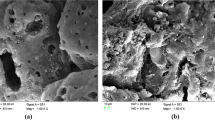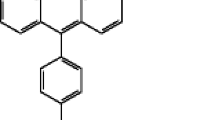Abstract
This study reports on the feasibility of remediation of catechol- and resorcinol-contaminated water using low-cost sunflower seed hull activated carbon (SSHAC). Sunflower seed hull (SSH), an abundant agricultural waste in Malawi, was used as precursor to prepare highly porous activated carbon by physicochemical activation, with zinc chloride (ZnCl2) as an activating agent. The activated carbon was characterized by FTIR, SEM-EDS, XRD and BET analyses. In this work, pertinent parameters that affect the adsorption efficiency—pH, initial adsorbate concentration, contact time, adsorbent dosage, and solution temperature—were investigated in batch mode. At the same experimental conditions, more catechol was adsorbed than resorcinol may be due to the compound’s affinity towards water and the position of the hydroxyl group on the benzene ring. A maximum equilibrium adsorption of 271 and 250 mg/g was obtained at pH 9.0 and pH 8.0 for catechol and resorcinol, respectively. The adsorption behaviour of both adsorbates (catechol and resorcinol) on SSHAC can be well described by Langmuir isotherm model and pseudo-second-order kinetic model. The value ∆G, ∆S and ∆H indicated spontaneous and endothermic adsorption process. The adsorption process was readily reversible allowing reusability of the adsorbate. This study’s outcome is value addition to this category of wastes for environmental protection.














Similar content being viewed by others
Change history
05 February 2019
In the original publication, the given name of the fourth author was mispelled as Adolp instead of Adolph. The correct name of the fourth author is Adolph Anga Muleja.
References
Abimbola, G., Zaman, Z., & Adeniyi, P. (2017). Equilibrium, kinetic, and thermodynamic studies of lead ion and zinc ion adsorption from aqueous solution onto activated carbon prepared from palm oil mill effluent. Journal of Cleaner Production, 148, 958–968.
Adib, M., Al-Qodah, Z., & Ngah, C. W. Z. (2015). Agricultural bio-waste materials as potential sustainable precursors used for activated carbon production: a review. Reneweable and Sustainable Energy Reviews, 46, 218–235.
Agarwal, S., & Rani, A. (2017). Adsorption of resorcinol from aqueous solution onto CTAB/NaOH/Fly ash composites: equilibrium, kinetics and thermodynamics. A. Journal of Environmental Chemical Engineering, 5, 526–538.
Ahmaruzzaman, M. D. (2008). Adsorption of phenolic compounds on low-cost adsorbents: a review. Advances in Colloid and Interface Science, 143, 48–67.
Ahmed, M. J., & Dhedan, S. K. (2012). Fluid phase equilibria equilibrium isotherms and kinetics modeling of methylene blue adsorption on agricultural wastes-based activated carbons. Fluid Phase Equilibrium, 317, 9–14.
Ai, L., Luo, X., & Lin, X. (2013). Biosorption behaviors of uranium (VI) from aqueous solution by sunflower straw and insights of binding mechanism. Journal of Radioanalytical and Nuclear Chemistry, 298(3), 1823–1834.
Akmil-Bas, C., & Köseog, E. (2015). Preparation, structural evaluation and adsorptive properties of activated carbon from agricultural waste biomass. Advanced Powder Technology, 26, 811–818.
Akram, M., Nawaz, H., Iqbal, M., Noreen, S., & Sadaf, S. (2017). Biocomposite efficiency for Cr (VI) adsorption: kinetic, equilibrium and thermodynamics studies. Journal of Environmental Chemical Engineering, 5, 400–411.
Banerjee, S., & Chattopadhyaya, M. C. (2017). Adsorption characteristics for the removal of a toxic dye, tartrazine from aqueous solutions by a low cost agricultural by-product. Arabian Journal of Chemistry., 10, S1629–S1638.
Basta, A. H., Fierro, V., El-Saied, H., & Celzard, A. (2009). 2-Steps KOH activation of rice straw: an efficient method for preparing high-performance activated carbons. Bioresource Technology, 100(17), 3941–3947.
Bayram, E., Hoda, N., & Ayranci, E. (2009). Adsorption/electrosorption of catechol and resorcinol onto high area activated carbon cloth. Journal of Hazardous Materials, 168(2–3), 1459–1466.
Dariush, R. (2013). Pseudo-second-order kinetic equations for modeling adsorption systems for removal of lead ions using multi-walled carbon nanotube. Journal of Nanostructure in Chemistry, 3(55), 1–6.
Chao, B., Iwan, M., Lin, L., Zappi, M., & Dianchen, D. (2017). Effect of carbon precursors and pore expanding reagent on ordered mesoporous carbon for resorcinol removal. Journal of Water Process Engineering, 17, 256–263.
Cohen, S., Belinky, P. A., Hadar, Y., & Dosoretz, C. G. (2009). Characterization of catechol derivative removal by lignin peroxidase in aqueous mixture. Bioresource Technology, 100(7), 2247–2253.
Demirbas, A. (2008). Heavy metal adsorption onto agro-based waste materials: a review. Journal of Hazardous Materials, 157, 220–229.
Dizbay-Onat, M., Vaidya, U. K., & Lungu, C. T. (2017). Preparation of industrial sisal fiber waste derived activated carbon by chemical activation and effects of carbonization parameters on surface characteristics. Industrial Crops and Products, 95, 583–590.
Deepak, P., Shikha, S., & Pardeep, S. (2017). Removal of methylene blue by adsorption onto activated carbon developed from Ficus carica bast. Arabian Journal of Chemistry, 10, S1445–S1451.
Fan, M., Marshall, W., Daugaard, D., & Brown, R. C. (2004). Steam activation of chars produced from oat hulls and corn stover. Bioresource Technology, 93(1), 103–107.
Ferna, C. (2006). Preparation of activated carbon from cherry stones by chemical activation with ZnCl2. Applied Surface Science, 252, 5967–5971.
Foo, K. Y., & Hameed, B. H. (2012). Potential of jackfruit peel as precursor for activated carbon prepared by microwave induced NaOH activation. Bioresource Technology, 112, 143–150.
Francisco, J. E., & Leitão, A. L. (2013). Hydroquinone: environmental pollution, toxicity, and microbial answers. BioMed Research International, 1–14.
Fu, K., Yue, Q., Gao, B., Sun, Y., & Zhu, L. (2013). Preparation , characterization and application of lignin-based activated carbon from black liquor lignin by steam activation. Chemical Engineering Journal, 228, 1074–1082.
Garba, Z. N., & Abdul, A. (2016). Evaluation of optimal activated carbon from an para-chlorophenol and 2,4-dichlorophenol. Process Safety and Environmental Protection, 102, 54–63.
Huang, J., Huang, K., & Yan, C. (2009). Application of an easily water-compatible hypercrosslinked polymeric adsorbent for efficient removal of catechol and resorcinol in aqueous solution. Journal of Hazardous Materials, 167(1–3), 69–74.
Hubicki, Z., & Barczak, M. (2005). Adsorption of phenolic compounds by activated carbon—a critical review. Chemosphere, 58, 1049–1070.
Hutdhawong, W. P., Howwanapoonpohn, S. C., & Uddhasukh, D. B. (2000). Electrocoagulation and subsequent recovery of phenolic compounds. The Japan Society of Analytical Sciences, 16, 1083–1084.
Iwan, M., Chao, B., Lian, Q., Subramaniam, R., Zappi, M., & Dianchen, D. (2017). Equilibrium, kinetic and thermodynamic studies for adsorption of BTEX onto ordered mesoporous carbon (OMC). Journal of Hazardous Materials, 336, 249–259.
Jigisha, P., Channiwala, S. A., & Ghosal, K. (2007). A correlation for calculating elemental composition from proximate analysis of biomass materials. Fuel, 86(12–13), 1710–1719.
Kumar, A., Kumar, S., & Kumar, S. (2003). Adsorption of resorcinol and catechol on granular activated carbon: equilibrium and kinetics. Carbon, 41, 3015–3025.
Kumar, S., Zafar, M., Prajapati, J. K., Kumar, S., & Kannepalli, S. (2011). Modeling studies on simultaneous adsorption of phenol and resorcinol onto granular activated carbon from simulated aqueous solution. Journal of Hazardous Materials, 185(1), 287–294.
Kwiatkowski, M., Fierro, V., & Celzard, A. (2017). Numerical studies of the effects of process conditions on the development of the porous structure of adsorbents prepared by chemical activation of lignin with alkali hydroxides. Journal of Colloid and Interface Science, 486, 277–286.
Lee, S. G., Lee, B. H., Baik, M.-Y., Park, S. K., Kim, B.-Y., Park, S.-J., Lee, J. H., Lee, C. Y., & Kim, D.-O. (2015). Activated carbon treatment of water extracts of Artemisia princeps Pampanini to retain bioactive phenolic compounds and remove volatiles. Food Science and Biotechnology, 24(3), 1097–1103.
Li, Q., Yu, H., Song, J., Pan, X., Liu, J., Wang, Y., & Tang, L. (2014). Synthesis of SBA-15/polyaniline mesoporous composite for removal of resorcinol from aqueous solution. Applied Surface Science, 290, 260–266.
Li, X., Xing, W., Zhuo, S., Zhou, J., Li, F., Qiao, S.-Z., & Lu, G.-Q. (2011). Preparation of capacitor’s electrode from sunflower seed shell. Bioresource Technology, 102(2), 1118–1123.
Liao, Q., Sun, J., & Gao, L. (2008). The adsorption of resorcinol from water using multi-walled carbon nanotubes. Colloids and Surfaces A: Physicochemical and Engineering Aspects, 312, 160–165.
Liu, Y., Gao, M., Gu, Z., Luo, Z., Ye, Y., & Lu, L. (2014). Comparison between the removal of phenol and catechol by modified montmorillonite with two novel hydroxyl-containing gemini surfactants. Journal of Hazardous Materials, 267, 71–80.
Oguntimein, G. B. (2015). Biosorption of dye from textile wastewater effluent onto alkali treated dried sunflower seed hull and design of a batch adsorber. Journal of Environmental Chemical Engineering, 3(4), 2647–2661.
Önal, Y., Akmil-Başar, C., Sarıcı-Özdemir, C., & Erdoğan, S. (2007). Textural development of sugar beet bagasse activated with ZnCl2. Journal of Hazardous Materials, 142, 138–143.
Opembe, N. N., Vunain, E., Mishra, A. K., Jalama, K., & Meijboom, R. (2014). Thermal stability of Ti–MCM-41. Journal of Thermal Analysis and Calorimetry, 117(2), 701–710.
Rashidi, N. A., & Yusup, S. (2017). A review on recent technological advancement in the activated carbon production from oil palm wastes. Chemical Engineering Journal, 314, 277–290.
Ren, L., Zhang, J., Li, Y., & Zhang, C. (2011). Preparation and evaluation of cattail fiber-based activated carbon for for 2,4-dichlorophenol and 2,4,6-trichlorophenol removal. Chemical Engineering Journal, 168, 553–561.
Saygili, H., & Güzel, F. (2016). High surface area mesoporous activated carbon from tomato processing solid waste by zinc chloride activation: process optimization, characterization and dyes adsorption. Journal of Cleaner Production, 113, 995–1004.
Schweigert, N., Zehnder, A. J., & Eggen, R. I. (2001). Minireview chemical properties of catechols and their molecular modes of toxic action in cells, from microorganisms to mammals. Environmental Microbiology, 3(2), 81–91.
Shakir, K., Ghoneimy, H. F., Elkafrawy, A. F., Beheir, S. G., & Refaat, M. (2008). Removal of catechol from aqueous solutions by adsorption onto organophilic-bentonite. Journal of Hazardous Materials, 150, 765–773.
Singh, H., Chauhan, G., Jain, A. K., & Sharma, S. K. (2017). Adsorptive potential of agricultural wastes for removal of dyes from aqueous solutions. Journal of Environmental Chemical Engineering, 5, 122–135.
Tan, I. A. W., Ahmad, A. L., & Hameed, B. H. (2009). Adsorption isotherms, kinetics, thermodynamics and desorption studies of 2,4,6-trichlorophenol on oil palm empty fruit bunch-based activated carbon. Journal of Hazardous Materials, 164(2–3), 473–482.
Umar Isah, A., Abdulraheem, G., Bala, S., & Muhammad, S. (2015). Kinetics, equilibrium and thermodynamics studies of C.I. reactive blue 19 dye adsorption on coconut shell based activated carbon. International Biodeterioration & Biodegradation, 102, 265–273.
Vunain, E., Davie, K., & Biswick, T. (2017). Synthesis and characterization of low-cost activated carbon prepared from Malawian baobab fruit shells by H3PO4 activation for removal of Cu (II) ions: equilibrium and kinetics studies. Applied Water Science, 7(8), 4301–4319.
Vunain, E., Opembe, N. N., Jalama, K., Mishra, A. K., & Meijboom, R. (2014). Thermal stability of amine-functionalized MCM-41 in different atmospheres. Journal of Thermal Analysis and Calorimetry, 115(2), 1487–1496.
Vunain, E., Mishra, A. K., & Krause, R. W. (2013). Fabrication, characterization and application of polymer nanocomposites for arsenic (III) removal from water. Journal of Inorganic and Organometallic Polymers and Materials, 23(2), 293–305.
Zapata-Benabithe, Z., Diossa, G., Castro, C. D., & Quintana, G. (2016). Activated carbon bio-xerogels as electrodes for super capacitors applications. Procedia Engineering, 148, 18–24.
Zou, Z., Tang, Y., Jiang, C., & Zhang, J. (2015). Efficient adsorption of Cr (VI) on sunflower seed hull derived porous carbon. Journal of Environmental Chemical Engineering, 3, 898–905.
Acknowledgements
This work was supported by the Department of Chemistry Research Fund, Chancellor College, University of Malawi. Many thanks to the Excellence Centers for Exchange and Development (EXCEED) programme, through the German Academic Exchange Service (DAAD) and the German Federal Ministry for Economic Cooperation and Development (BMZ) for an award of a three-month research grant. The authors would like to thank the University of South Africa, for the use of their SEM-EDX, Zetasizer and TGA instruments for characterization.
Author information
Authors and Affiliations
Corresponding author
Ethics declarations
Conflict of Interest
The authors declare that there is no conflict of interest.
Rights and permissions
About this article
Cite this article
Vunain, E., Houndedjihou, D., Monjerezi, M. et al. Adsorption, Kinetics and Equilibrium Studies on Removal of Catechol and Resorcinol from Aqueous Solution Using Low-Cost Activated Carbon Prepared from Sunflower (Helianthus annuus) Seed Hull Residues. Water Air Soil Pollut 229, 366 (2018). https://doi.org/10.1007/s11270-018-3993-9
Received:
Accepted:
Published:
DOI: https://doi.org/10.1007/s11270-018-3993-9




